
|   |

|   |
 e-mail: ukb7@rediffmail.com Virtual and virtuoso Photos courtesy: Art Vision November 17, 2020 Ileana Citaristi, the celebrated Odissi dancer in India today, did not have it all laid down for her on a silver platter. Born and brought up in Italy, she had imbibed the best of her culture and acquired performing arts skills, including an exemplary grooming in contemporary theatre from the Polish maestro Jerzy Grotowski (1933-1999), an innovative theatre director and theorist whose approaches to acting, training and theatrical production have significantly influenced theatre today. In June 1979, having decided to come to India by land route from Europe, Ileana did not have it all hunky dory. Roughing it out over a perilous journey, when she finally arrived here to learn dance, the sub-continent was not exactly ready for her with welcoming arms. This critic was acutely aware of her arduous situation at that time when she had huge problems in eking out even a decent, daily living. Having roughed it out over four long decades and having simultaneously learnt her art and craft in Odissi and Chhau from the very best of gurus, she had stuck to her steely resolve to settle in India and become a really good performer, choreographer, teacher and scholar. If today she has an idyllic cottage for living, practising and teaching in Bhubaneswar near Lingaraja temple - where, among other things, she is able to offer an excellent fare of lec-dem to interested foreign visitors every year under the aegis of Odisha tourism - it goes to her immense credit to have come this far. Additionally, she has put in a credible effort in innovating new quality of choreographic content year after year and have them showcased with her students, besides writing her academic tomes. No wonder she has earned accolades. 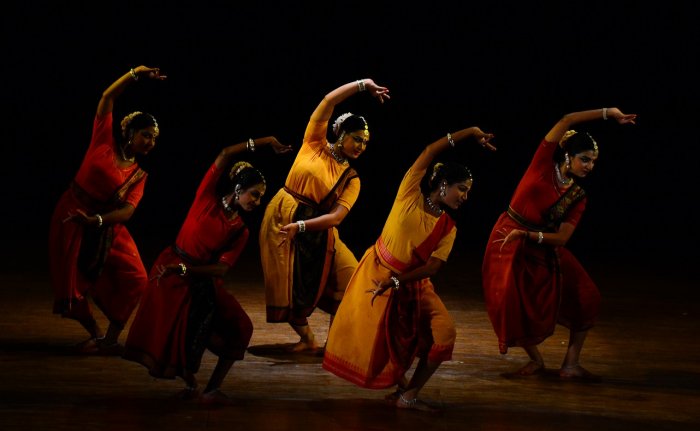 Maya Darpana In the online 16TH SANGAM FESTIVAL held from November 7 to 9, Ileana presented a mix of four hardy favourites resurrected from earlier years, with three new items. In the curtain-raiser MAYA DARPANA, the abstract concept of Maya -- suggested to her by the Odissi scholar Jiwan Pani - was rendered through movements and formations in space, distinguishing what was considered integrated being actually separate entities and what was looked at as timeless turning out to be perishable. Movements on the floor were explored to suggest the rolling of elements in the preliminary stage of creation of the universe, followed by long-drawn sensual interplay between female and male. Ileana recalls, "It generated quite a controversy for the unconventional approach to the theme, unconventional costumes and novelty of movements employed. Yet, appreciated by the public, it was labelled as 'choreographic masterpiece' by Guru Kelucharan Mohapatra." Music was by Partho Das and rhythm set by Prafulla Mangaraj. See video 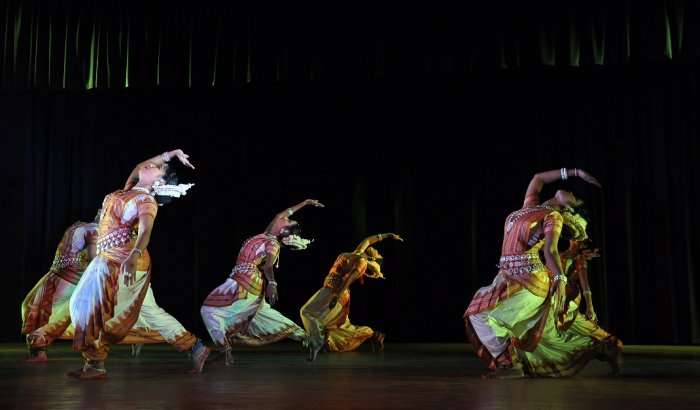 Kaala In the second item KAALA inspired by the path-breaking visual exhibition on the same subject mounted by IGNCA, New Delhi, in November 1990, conceived and curated by Dr. Kapila Vatsyayan, the choreography travelled from the latent aspect of the un-manifested Time (hridya) to the first pulsation (spandan), transition of primal elements to organic life. For man to comprehend the movements of Time, the dancers used a language of geometry: lines, concentric circles, cones, squares and triangles. Profane Time was conceived as an arrow which journeyed through past, present and future, and the Sacred Time moved in circles through the path of myths and eventual return. Time devoured what it conceived as an eternal cycle of creation and destruction (Kaala chakra). Man aspired to reach a state of transience passing into timelessness, to live finally in a perennial Now. There was also the image of the swan ending at its eternal home in the celestial lake, tempted no more to fly off elsewhere. It was an excellent abstract metaphor explored to the core. Music was by Annada Prasanna Patnaik, with text provided by Devdas Chhotray. See video 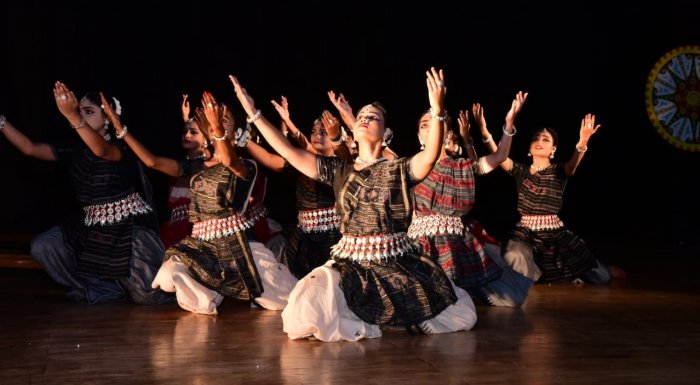 Refugee On the second day, REFUGEE (brought forward from 2018 when this critic had witnessed it live) lamented the time when man's travel path was free like a bird's flight; the world was un-demarcated like the sky and the oceans, and a traveler could select as home wherever he reached! The world has changed irrevocably today with victims of violence, religion and politics making thousands of innocent and non-aggressive people become refuges everywhere, with their earth dissected, their geography scuttled. They move on unremittingly in sand and snow, along the railways tracks and in shaky sailing boats, and have no address of their own. The choreography was heart-wrenching, as an artistic reaction to our times, intended to heal the wounds caused by hatred and greed, through a message of amity and peace conveyed through dance. The touching script was by Devdas Chhotray and music by Laxmikanta Palit. See video 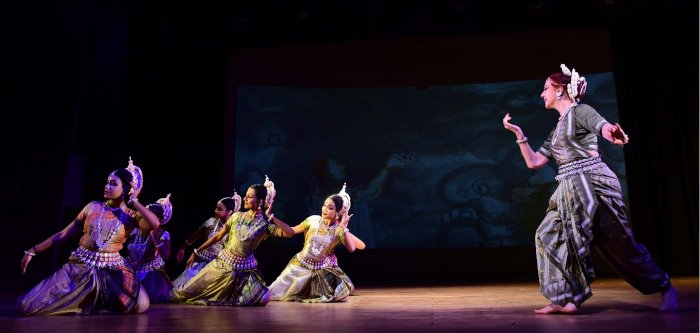 Meghadootam The second item was the charming MEGHADOOTAM by Kalidasa (presented earlier in Sangam 2019), a lyrical commingling of love and nature, with the poet describing birds, cranes, peacocks, flowers, mountains and rivers, as miniature paintings and backdrops to the sentiment of deep love recreated in the anguish of separation. The advent of monsoon gives hope to the lover to entrust to the fleeting cloud his message for the beloved living far away in the Himalayas. The cloud is urged not to tarry in its journey by the cries of the peacocks or the fragrance of the kutaja flowers, but should illuminate the path -- through its lightning ---to the women who are trysting in the dark night to meet their lovers. After crossing the locale where the Ganga descends on earth, the cloud should gently awake his beloved - to be recognized by her beauty nonpareil - for passing on the love message to her. With statuesque Ileana playing Yaksha and the petite dancers as cloud devising their many delightful formations and patterns, the piece comes through with an ineffable charm, making this critic reminisce on her choreographic work on the love-myth of Greek god Narcissus quite some time ago. Music was by Laxmikanta Palit, rhythm by Satchidananda Das and visuals by Helen Brahma. See video PALLAVI in raga Bhairavi and taal ektali set off the original choreographies ceated in this fractured year and seemed of little cosequence. Set out as a quest by well-decorated dancers for harmony, symmetry and synchronization between music, rhythm and dance, the item somehow missed out on the heartbeat of this most beautiful raga. Music was by Laxmikanta Palit and rhythm by Ratikant Mohapatra. 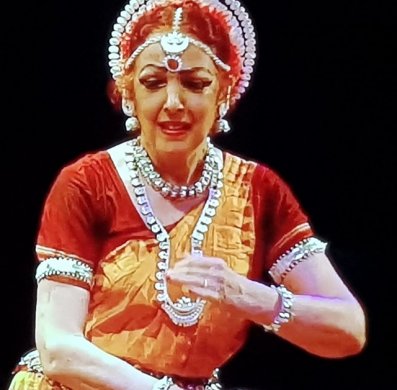 Anyaaya ANYAAYA (Injustice) suffered by three women from mythology and their revenge depicted by Ileana in ekahara abhinaya, was much too compressed for the full play of wrath by these heroic women. Amba outraged by Bhishma, Medea cheated in love by husband Jason, and Draupadi disrobed of her dignity by the clan of Kauravas, take justice in their own hands and eke out their own terrible revenge. Music was by Gopal Panda, with script by Prafulla Misra. 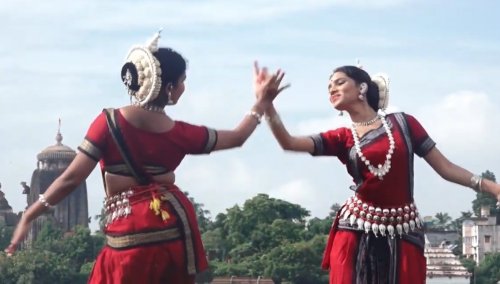 Sparsh SPARSH (Touch) was the finale between a dancer-duo who responds to the rhythm created by the percussion (by Budheswar Swain) and at the same time create their own rhythm by contact with each other. See video The choreographer is a noted and hugely talented artist. With her chequered upbringing and creative prowess, she is quite accustomed to deviate from the archetypes and stereotypes of mythology - comparable to Karl Jung's "collective unconscious". One would, therefore, wish she follows the footsteps of stalwarts like Chandralekha and Kumudini Lakhia and use her considerable talents to create a nuanced choreographic oeuvre of high dramatic intensity- that would last long, and inspire today's talented and widely-exposed millennials to depart from the traditional legacy and create their own innovative corpus attuned to their present times!  Dr. Utpal K Banerjee is a scholar-commentator on performing arts over last four decades. He has authored 23 books on Indian art and culture, and 10 on Tagore studies. He served IGNCA as National Project Director, was a Tagore Research Scholar and is recipient of Padma Shri. Post your comments Please provide your name and email id when you use the Anonymous / blog profile to post a comment. All appropriate comments posted with name and email id in the blog will also be featured in the site. |